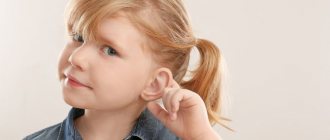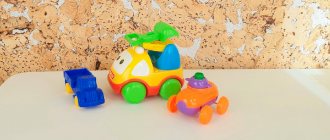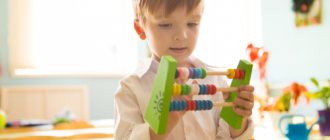There are certain sensitive (favorable) periods for the development of each mental cognitive process: thinking, memory, attention, perception and speech itself. It is very important that each stage of speech development, from humming to coherent speech, occurs in a timely manner. Starting speech in non-speaking children is a necessity if, at two years or more, the child does not speak at all, or pronounces babbling chains or several individual words.
It is very important for parents to understand that if you close your eyes to this problem, it will not only not disappear, but will only worsen the situation over time. Speech therapy work with non-speaking children should be carried out according to the characteristics and severity of the disorders.
What to pay attention to
When should you start sounding the alarm? So, this is necessary in cases where:
- The babbling chains of children are homogeneous, rare, and do not turn into words.
- By the age of 1.5 years, the intonation-rhythmic organization of speech in the baby is not formed.
- At 2-3 years old, a child does not understand speech addressed to him, even if an adult uses monosyllabic sentences and simple words.
- The child understands, but does not speak, or uses only a few words in communication. There is no phrasal, and especially coherent, speech.
- Physiological hearing impairment (deafness, hearing loss) was detected.
- The baby “speaks” in some kind of his own (bird) language, which no one understands.
3.Show the picture!
Goal: clarification and expansion of children’s passive subject vocabulary on various topics. Materials: subject pictures on different topics according to the number of children. How to play: The game is played on the carpet. Place the children in a circle on the floor. Place object pictures face up in front of them. Take turns asking the children to find and show the correct picture. Look how many beautiful pictures we have. All pictures are different. Vanya, show me the cube. Right. Lena, find and show the pyramid. Well done! Sasha, show me the plane. Etc. In this game you can select pictures by theme, or you can mix pictures from different themes. Over time, you can increase the number of pictures used in the game.
Causes and mechanisms of the disorder
The reasons may be social or biological. The first group includes:
- Lack of communication (verbal, emotional) between adults and the child. The experiment with infants is based on comparing the psycho-emotional state of the subjects. For a certain period of time, some newborn children were placed in a room with white walls, isolated from extraneous sounds and other external stimuli. The children were not picked up; they were only given the necessary care. In another room there was a second group of subjects, where a favorable environment was created, the babies were not only fed and swaddled, but also picked up, rocked, and talked to. At the end of the experiment, when summing up the results, it was noted that the mental development indicators of the children of the first group were significantly lower than those of the children of the second. This experience confirms the fact that the lack of an emotional connection between mother and child and a lack of communication can further negatively affect the formation of speech.
- Using multiple languages in the family. Bilingual children are the name given to those who are raised in a bilingual family. If a child is exposed to speech in different languages, then at some point “stupor” may occur. Speech therapy work with such children should be carried out only in one (leading) language; if this condition is neglected, the situation can be aggravated. It is also undesirable for several speech therapists to work with the child, since different specialists may choose different methods for training, which will only complicate the perception of new material.
Biological reasons:
- Difficult or unnatural labor (eg, caesarean section and prolonged labor).
- Fetal hypoxia (lack of oxygen) during intrauterine development, which in turn leads to disruption of metabolic processes and a delay in the formation of the central nervous system.
- Birth injuries in a newborn: if the cerebral cortex is damaged, if the speech zone is affected, the manifestation of pathology will definitely be the consequence.
- Head injuries, especially at an early age.
- Infectious diseases suffered in the first year of life, which subsequently caused complications.
Classification of violations
A correctly made diagnosis plays a very important role, since the correctional technique included in the speech therapist’s work plan is effective for one type of disorder, but may be completely unsuitable for another. If we classify the types of speech disorders in non-speaking children, the following diagnoses should be noted:
- All disorders associated with speech pathology in children are combined into GSD (general speech underdevelopment). The diagnosis is general in nature, so if the child was given it after the examination, it is important to pay attention to its level, since OHP can be from the first to the fourth degree. If the speech therapy report shows ONR type I, this indicates that the child partially or completely lacks speech and (or) understanding of it.
- SSD (systemic speech underdevelopment) is a persistent disorder in children with disabilities (disabilities). Profound SUD is characterized by a disorder of coherent speech, a poor vocabulary and problems in understanding. The diagnosis can be made for children with mental retardation, severe mental retardation, cerebral palsy, etc.
- Alalia. This diagnosis indicates that the child either completely lacks speech itself or understands it. The first condition is typical for the motor type of pathology, the second – for the sensory one. If both reproduction and understanding are impaired, then a diagnosis of sensorimotor alalia is made. Such a conclusion can be given in parallel with childhood autism, but not necessarily. It should also not be confused with echolalia, a disorder in which there is repetition of ready-made speech structures: sentences, phrases, words. It looks like a child is imitating. The main task of this specific speech disorder, as paradoxical as it may sound, is interaction with others. Normally, all children repeat certain words or phrases after adults, this allows them to better remember new material and later use these constructions in their own speech. But in children with echolalia, this process stops at the initial stage. One of the main reasons for this may be damage to the central nervous system.
- Aphasia. This diagnosis can be made even to an adult. It differs from the previous one in that in this case certain speech areas of the cerebral cortex may be affected: the person will have difficulty expressing himself, or may not understand the speech addressed to him. Aphasia is often a consequence of a stroke.
- SRD (delayed speech development) is a lag behind the norms of development and formation of speech with initially intact intelligence. In other words, if a child uses only 5-10 words in his active vocabulary at two years of age, whereas normally these indicators reach 300-400, then, accordingly, the developmental disability is evident. However, only a qualified specialist can make an accurate diagnosis, since all types of disorders are similar to each other. If a baby at 2-3 years old uses only individual syllables or babble, and zero words, then this is not a delay; here the diagnosis will be more serious.
Most often, problems in the development of one mental function entail a lag in the formation of other cognitive components: when speech is delayed, attention, memory, and thinking are impaired. Therefore, at 3-4 years old, a child with mental retardation development will most likely be diagnosed with mental retardation disorder - delayed psycho-speech development. Children with this diagnosis are recommended to study in a correctional institution, since speech therapy work alone will not be enough in their case.
Several diagnoses can be written in the diagnostic chart at once. For example, they can write related ones, such as autism, echolalia, mental retardation, etc. However, you should not be afraid of the medical reports obtained based on the results of the examination. Effective comprehensive correctional work, especially started in the early stages, will bring it to a high-quality level and compensate for deficiencies in psycho-speech development.
For most of the listed violations, defectological assistance is required.
Starting speech in non-speaking children from zero to phrase speech is necessary primarily for those who suffer from alalia. The most difficult thing is to work with children diagnosed with the sensorimotor type of this disorder. In this case, other specialists are also involved, in particular, a defectologist and a psychologist are directly involved in the process of correcting disorders in alaliks. First, the work will be aimed at developing understanding, then only speech motor skills.
When do you need classes with a speech therapist or speech pathologist?
Classes with a children's speech therapist (group or individual) on evoking speech are required if:
- parents talk and play a lot with a three-year-old child, but speech still does not start;
- due to speech disorders, it is difficult for a child to adapt to a preschool institution;
- a preschooler over three years of age pronounces some consonant sounds poorly, replacing them with others;
- the child negatively perceives any attempts to get him to talk made by elders.
As practice shows, in 90% of cases, the timely intervention of a speech therapist helps to easily solve the problem and remove the diagnosis of speech development delay (speech development delay) within a few months of a systematic course of classes using one method or another.
A professional speech therapist will help you develop phrasal speech and close the gap with your peers
The main thing that parents should remember is: under no circumstances should you show your child worries about his retardation in speech development. The fear and panic of adults is transmitted to the baby, and this only aggravates the current situation. On the contrary, the calmness of elders will help to evoke speech and overcome all difficulties. First, you can try to fix everything yourself, and if nothing works, then contact a specialist.
Corrective work for sensory alalia
Speech therapy work with non-speaking children 3-4 years old suffering from alalia is structured depending on the type of this disorder. If a diagnosis of sensory alalia has been established, then the speech understanding disorder will be corrected by working with intact analyzers, that is, through tactile, olfactory, gustatory and visual perception. The auditory system is not ignored, but is included in the work partially and only at later stages.
There are several stages of work to correct and eliminate speech disorders in the sensory type. Conventionally, they can be divided into:
- Stage I – preparatory.
- Stage II – formation of communication skills (from non-speech to speech).
- Stage III – development of interest in surrounding non-speech and speech sounds.
First stage
Before starting correctional work to eliminate speech disorders, it should be understood that, although it is customary to take methodological developments adapted for hard of hearing and deaf children as a basis, nevertheless, lack of hearing and misunderstanding of speech are two completely different concepts and require radically opposite in some cases approach. This must be taken into account when choosing techniques and methods for teaching children with sensory alalia.
These children hear, but the process of analyzing the information received is disrupted: the auditory analyzer can perceive the signal at the moment, but after some time under the same conditions it cannot. In the familiar environment of their home, they can remember individual speech structures used by adults. At the same time, when they find themselves in an unfamiliar environment, or when they come into contact with a new person, they do not understand the same statement. The auditory system of alaliks is extremely unstable; children with this perception disorder have a hard time tolerating sharp sounds (creaks, rustling), high-frequency noises, screaming or loud expressive speech. All this can lead to blocking the acoustic-gnostic process, which will only complicate the correction work. Therefore, during classes with such children it is necessary to use calm, quiet speech so as not to reduce their perception of speech sounds.
Often concomitant disorders in children with sensory or sensorimotor alalia are disturbances in the emotional-volitional sphere and behavior, so at first, classes with the child will most likely be chaotic, spontaneous. Under no circumstances should you try to force an alalik to “sit” in one place for a certain number of minutes. One of the main initial tasks is to establish contact with the child at the level of tactile and visual perception. Only after contact has been established can work begin, otherwise all efforts will go down the drain.
Second phase
Children, through joint play activities with a teacher, learn to use non-verbal communication skills - gestures, facial expressions. Later, semantic intonation is added. This happens when playing partner games with a child, for example:
"Feed the doll." The speech therapist speaks and shows what needs to be done: sits the doll on a chair (at the table), holds a spoon to the toy’s mouth, imitating “feeding,” etc. The child, in turn, performs the same actions, duplicating gestures and facial expressions. Here, motor and visual analyzers are actively involved in the work, the “eye to eye” technique is used, which allows the baby to better understand what the adult wants from him. However, this method is not suitable for children with autism, as they often tend to avoid eye contact with other people.
Games with construction sets or cubes will also be useful. This version of “parallel play” is also suitable for autistic people. Tactile and visual perception and sensation are involved. The teacher builds a tower or other structure together (if this does not cause negative emotions) or next to the child, using facial expressions and gestures. Speech is minimal, simple, monosyllabic, there should not be too many words in use, it is better to rely on those that the child perceives or can often hear.
You can also work with various aids for the development of sensory skills (color, taste, tactile features of objects) and fine motor skills: musical toys, soft and wooden cubes. The goal of the second stage is to directly formulate the need for verbal communication. It can be developed with the help of an artificially created “information hunger.”
Third stage
At this stage, the gradual development of phonemic hearing and perception begins. First with the help of non-speech sounds, then with the inclusion of adult speech. In this case, it is necessary to avoid sharp knocks, clapping of hands, and stomping. The sound is compared to the displayed image. For example, a speech therapist offers a pupil a number of illustrations for the development of subject vocabulary. Next, he parses each picture with one or more sounds corresponding to it (uu - paravoz, yy - bear, mu - cow, etc.). The same thing happens when the symbols of actions are activated: a selection of plot pictures allows you to expand the verbal dictionary (aa - cries, ay - hurts, etc.).
You can use ready-made material “My First Words” by N. A. Shishkina, developed in accordance with the modern psycholinguistic approach, and systematized into blocks for more convenient study of information. This manual is suitable for working with both sensory and motor skills.
Before starting work, it is recommended to establish a routine, clearly define the time for classes and rest. You need to try once again not to overload auditory attention and perception with speech tasks.
This stage will be fundamental in the development of speech understanding, as it will allow:
- intensify the use of words according to their purpose;
- develop the ability to analyze one’s own speech;
- replenish passive vocabulary, which, subject to the effective work of the speech therapist, will eventually turn into active;
- develop phonetic-phonemic perception: distinguish words that sound similar.
Groups of words suggested for memorization.
1. Subject dictionary.
Toys: ball, cube, car, doll, bear, bunny, ball, spinning top, bucket, shovel, pencils, book, etc. Parts of the body, face: legs, arms, belly, back, finger, head, neck, hair, eyes , ears, mouth, lips, teeth, nose, cheeks, eyebrows, forehead. Clothing and footwear: hat, scarf, mittens, jacket, coat, dress, skirt, blouse, shirt, trousers, tights, briefs, T-shirt, socks, slippers, boots, shoes, sandals, etc. Toilet items: soap, toothbrush, toothpaste, sponge, towel, comb, handkerchief, etc. House, apartment: house, door, lock, key, stairs, elevator, window, kitchen, room, bathroom, lamp, floor, ceiling, wall, etc. Furniture: table, chair, sofa, bed, wardrobe, shelf, hanger, etc. Household items: TV, telephone, clock, stove, refrigerator, fork, spoon, plate, cup, blanket, pillow, mirror, etc. Food and dishes : bread, bun, cheese, sausage, sausages, milk, butter, sour cream, cottage cheese, yogurt, cookies, juice, egg; porridge, soup, salad, sandwich, tea, compote, etc. Vegetables and fruits: cabbage, potatoes, carrots, onions, cucumbers, tomatoes; orange, banana, apple, pear, plum, etc. Plants: tree, bush, grass, flowers, berries, etc. Names of animals and birds that the child often sees: dog, cat, bird, dove, sparrow, crow, horse, etc. etc. Individual names of objects in the surrounding life: street, road, traffic light, cars, plane, swing, slide, park, etc. Individual names of phenomena in the surrounding life: water, earth, sun, sky, rain, snow, night, day, etc.
2. Verb dictionary.
The child’s own actions: walks, sits, stands, runs, jumps, sleeps, eats, plays, draws, builds, walks, rolls, washes, bathes, dresses, undresses, combs his hair, carries, falls, screams, speaks, sweeps, wipes and etc. Names of actions that people close to the child perform: reads, writes, draws, cleans, washes, irons, cooks, fries, sweeps, etc. Other actions: the phone rings; the car drives and hums; The plane is flying; leaves are falling, etc.
3. Adjectives, adverbs.
Names of some sensations and states: sweet, salty, sour, wet; cold, warm, hot, painful, tasty.
The name of some concepts: big, small; a lot, a little.
Work to expand the passive vocabulary of non-speaking children 2-3 years old is carried out both by a speech therapist and by the child’s relatives. Therefore, a speech therapist not only works with the child, but also works with parents.
Corrective work for motor alalia
Motor alalia is characterized by underdevelopment of expressive speech or its absence; in this case, classes with a specialist will be aimed at starting speech. The preparatory stage of speech therapy work is aimed at evoking speech sounds, using the pitch, strength of the voice, and its rhythmic and intonation components. To do this, they use the method of “singing” vowels when merging sounds into syllables, or in isolation. At the same time, finger exercises, breathing and articulation exercises are used.
Corrective activities carried out at the main stage are based on:
- development and expansion of passive vocabulary;
- activation of new words;
- formation of the grammatical aspect of speech;
- formation of phrasal speech;
- development of coherent speech.
In the future, it will be necessary to correct the sound pronunciation. This work is carried out as part of the formation of a grammatical structure.
Evoking speech in non-speaking children with motor alalia, as well as with sensory alalia, is carried out in several stages from simple to complex, but with one difference: the need for communication in children of this group is not impaired, therefore the method of “information hunger” is not used in this case . On the contrary, a child with motor alalia needs qualitatively new information.
Initiating speech in non-speaking children: modern techniques
Before starting a child’s speech, you need to motivate the preschooler to clearly pronounce words, phrases, and then full-fledged phrases and sentences. To motivate him to communicate and stimulate mental development, you need to improve:
- touch;
- tactile sensitivity;
- sensory
GCD for speech development in the preparatory group for the Federal State Educational Standard
To do this, you can use a range of children's educational games using didactic materials.
Forecasting and corrective measures
The sooner the work begins, the greater the chance of compensating for speech impairment in children with mild or moderate forms of underdevelopment of certain mental functions. The task of corrective influence on children with severe forms of pathology is to support and develop as much as possible communication and self-care skills, so that in the future special children have the opportunity to socialize in society.
The most important condition when starting a speech is the timeliness of correctional work and an integrated approach. In parallel with pedagogical classes, for any speech disorder that has a biological cause, a course of treatment with medications corresponding to the established diagnosis is prescribed. If the cause of mild RRD in a child with intact intelligence is found to be weak innervation of the organs of the speech apparatus, it is recommended to include speech therapy massage and articulation gymnastics in the complex of classes as a preventive measure.
If already at the age of 2-3 years the child was diagnosed with sensory alalia, and the baby’s parents turned to a speech therapist for help only at the age of 5-6, then you need to understand that the underdevelopment of speech has progressed over all this time. At this age, sensorimotor alalia is already established in all children.
Non-verbal children with disabilities are often homeschooled. Their parents are required to take a direct part in the speech therapy process.
12.Where is what?
Goal: to teach children to understand the spatial relationships of two objects, expressed by the prepositions on, under, in, about. Materials: box, several small toys. How to play: Place a box with a lid on the table, and several small toys next to it. Place one toy in the box, another under the box, a third on the box, a fourth near the box. Accompany your actions with appropriate words. The names of prepositions should be highlighted in the sentence. Here's a pencil. I put the pencil in the box. Where is the pencil now? In the box. Here's a picture. I put the picture under the box. Where is the picture now? Under the box. Etc. After explaining and demonstrating actions with objects, invite the children to act according to the instructions. Lena, put the pencil under the box. Sasha, put the cube on the box. Etc. This game can be played in another way. Before the game starts, children are given toys. Then they give tasks. Vanya, here's a bear for you. Place the bear on a chair. Lena, here's a ball for you - hide the ball under the table. Katya, put the book in the closet. Etc. It is useful to repeat such games using different subject material, which allows children to consolidate their understanding of spatial relationships.
Literature
- Zhukova N.S., Mastyukova E.M., Filicheva T.B. Overcoming general speech underdevelopment in preschool children - M.: Education, 1990.
- Kataeva A.A., Strebeleva E.A. Didactic games and exercises in teaching mentally retarded preschoolers. – M.: Book-master, 1993.
- Kozak O.N. Games and activities for children from birth to three years old. – St. Petersburg: Union, 1998.
source - Part 1. Journal "Education and training of children with developmental disorders" No. 5, 2004
Series of messages “speech therapy”:
Part 1 - Speech therapy lotto. Learning sounds [P] - [P'] Part 2 - Demonstration material for classes with preschoolers. Speech therapy... Part 4 - ARTICULATIVE GYMNASTICS-1 (2-4 years). Part 5 - Smirnova L.N. Speech development in children 2-3 years old Part 6 - Speech therapy classes with non-speaking children 2-3 years old. E. A. Yanushko Part 7 - Novikova E.V. “Speech therapy alphabet. Part 8 - Volkova G.A. “An album for the study of the phonetic and phonemic aspects of doshko speech... Part 12 - Poems for cheerful fingers))) Part 13 - Types of rhotacism. Pararotacism. Correction of sound R. Part 14 - Game library of speech games. Issue 12




